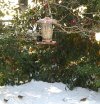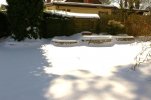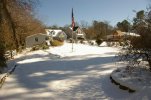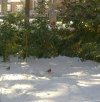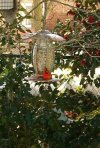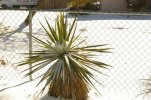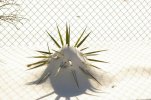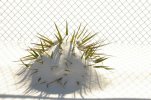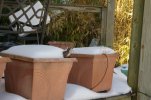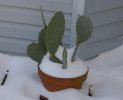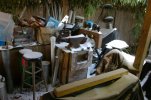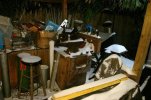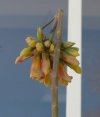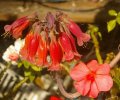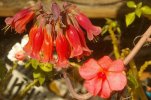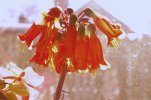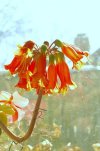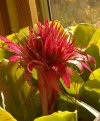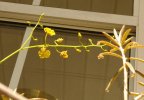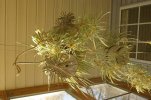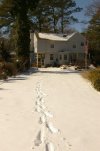Stacy E. Apelt - Bladesmith
ilmarinen - MODERATOR
Moderator
Knifemaker / Craftsman / Service Provider
- Joined
- Aug 20, 2004
- Messages
- 37,953
I shot some photos of the yard after the snowfall.It had partly sublimated and wasn't as deep as after the storm, but there is still about 6-7" in most places. While out shooting the pics, I took one from the back of my second lot, where the new shop will be. The existing wood shop will be moved closer to the house, and become a utility building and garden shed.
There was some snow that blew in the smithy, buy I blew it out with a leaf blower.
I shot a few pics of the birds on the feeder. There is usually a big batch of jays, cardinals, downy woodpeckers ( on the suet feeder), sparrows, finches, chickadees, doves, red-wing blackbirds, thrushes, etc......and squirrels. My shop cat loves the birds, and lays out in the sun watching them. The birds have become used to her, and pay little attention, unless she walks over to see if one wants to play. She has never tried to catch one yet. The sparrows and cardinals will still eat on the feeder when she lays below it watching them. The main group flew away when I came around the corner, but some cardinals, sparrows, and a red-wing stuck around for some photos.
I also took some photos of the plants in the snow. The Yucca look funny buried in snow. The cactus,too.
I went to the greenhouse and took some photos. One orchid is starting to bloom.There are some shots of a succulent I have that has been thriving for years. It was propagated from an original plant bought at a show of the Santa Barbara Cactus and Succulent Society back in the 1980's. The plant was a gift, and I never knew its actual name.We just call it "The Santa Barbara succulent". It is a woody stemmed, running succulent that forms small "babies" ( sort of a "Hens-and-Chicks" looking thing) which fall off and become new plants. It drops hundreds (maybe thousands) on an old plant.I have several snaking around the greenhouse windows, and its babies have been put in all the hanging pots in the green house for a tropical jungle look. On occasion it blooms with a fantastic cluster of orange/red flowers. It is a tropical succulent and dies with cold weather, and will not survive freezing. I propagate it into many places and containers around the yard in the spring, and by summer it is a wonderful accent. I move a few pots of it into the greenhouse during the winter to provide the babies to put out in the spring. There is a chiminea on the deck that I use as a big planter. I grow the succulent spilling out of the fire pot and in dirt in the chimney hole. The plant gets tall in the top. Once the frost comes, it dies. This winter we had a period of nearly two weeks with night temps in the 20's, and continuous sub-freezing temps for several days on end. There was this one stalk in the top of the pot that sits right outside the bay window of the dinette. The main plant died but this stalk held on through temps in the teens. Maybe it is able to absorb some heat transferred from the window panes? The babies all fell off and it looked like it had finally become a dead woody stalk....then a bloom appeared. All this in sub freezing weather, and now snow. The colors are not as vibrant as the one in the greenhouse, but it is amazing how nature will survive.
Enjoy - Stacy
There was some snow that blew in the smithy, buy I blew it out with a leaf blower.
I shot a few pics of the birds on the feeder. There is usually a big batch of jays, cardinals, downy woodpeckers ( on the suet feeder), sparrows, finches, chickadees, doves, red-wing blackbirds, thrushes, etc......and squirrels. My shop cat loves the birds, and lays out in the sun watching them. The birds have become used to her, and pay little attention, unless she walks over to see if one wants to play. She has never tried to catch one yet. The sparrows and cardinals will still eat on the feeder when she lays below it watching them. The main group flew away when I came around the corner, but some cardinals, sparrows, and a red-wing stuck around for some photos.
I also took some photos of the plants in the snow. The Yucca look funny buried in snow. The cactus,too.
I went to the greenhouse and took some photos. One orchid is starting to bloom.There are some shots of a succulent I have that has been thriving for years. It was propagated from an original plant bought at a show of the Santa Barbara Cactus and Succulent Society back in the 1980's. The plant was a gift, and I never knew its actual name.We just call it "The Santa Barbara succulent". It is a woody stemmed, running succulent that forms small "babies" ( sort of a "Hens-and-Chicks" looking thing) which fall off and become new plants. It drops hundreds (maybe thousands) on an old plant.I have several snaking around the greenhouse windows, and its babies have been put in all the hanging pots in the green house for a tropical jungle look. On occasion it blooms with a fantastic cluster of orange/red flowers. It is a tropical succulent and dies with cold weather, and will not survive freezing. I propagate it into many places and containers around the yard in the spring, and by summer it is a wonderful accent. I move a few pots of it into the greenhouse during the winter to provide the babies to put out in the spring. There is a chiminea on the deck that I use as a big planter. I grow the succulent spilling out of the fire pot and in dirt in the chimney hole. The plant gets tall in the top. Once the frost comes, it dies. This winter we had a period of nearly two weeks with night temps in the 20's, and continuous sub-freezing temps for several days on end. There was this one stalk in the top of the pot that sits right outside the bay window of the dinette. The main plant died but this stalk held on through temps in the teens. Maybe it is able to absorb some heat transferred from the window panes? The babies all fell off and it looked like it had finally become a dead woody stalk....then a bloom appeared. All this in sub freezing weather, and now snow. The colors are not as vibrant as the one in the greenhouse, but it is amazing how nature will survive.
Enjoy - Stacy

